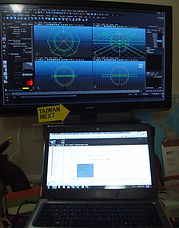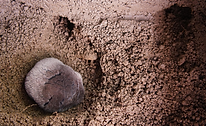
Biomechanics and Functional morphology
RESEARCH
Having strong interests in animals, aesthetics and sports, I am fascinated in the fantastic world of animal locomotion. Moving efficiently through different media involves the interaction between sophisticated architecture (musculoskeleton and tendon/ligament system) and materials (material properties of tissues) that are both shaped by evolution. Here I address two topics I have been working on: 1) the biomechanics of burrowing, an energetically expensive and largely unknown type of locomotion, and 2) the biomechanical and behavioral functions of sesamoid bone, an important source of morphological and functional novelty in evolutioin.
Biomechanics of burrowing
2011-present (PhD research)
Fossoriality has evolved multiple times in mammals as a strategy for reducing exposure to predation while foraging. Burrowing, however, is an energetically expensive form of locomotion that involves loosening and removing soil as an animal tunnels. Species that use burrowing as the primary mode of locomotion often have distinct morphologies, such as enlarged palms, rostrally migrated shoulder joints, short forelimbs and robust humeri. Although these morphological specializations have long been hypothesized to be adaptations to increase burrowing efficiency, the detailed mechanics of burrowing and how morphological specializations might facilitate burrowing performance is unclear.
Moles (Talpidae) present an excellent system for studying burrowing mechanics and establishing the link between morphology and burrowing performance. First, their unique “lateral strokes” simultaneously loosen and remove soil, allowing simple examination of forelimb performance during burrowing. Second, they exhibit a wide spectrum of burrowing behavior (semi-fossorial, aquatic/fossorial and fossorial) and morphological variation in the forelimb skeleton (e.g., long, intermediate and round humeri).
I plan to study three North American moles (Scalopus aquaticus, Condylura cristata and Neurotrichus gibbsii) to investigate questions at functional, morphological and ecological levels:
(1) Does burrowing kinematics vary among species with different degrees of fossoriality?
(2) How do differences in humeri morphology contribute to variation in the burrowing kinematics?
(3) Does burrowing performance change with the physical properties of the substrate?
I will combine anatomy, behavioral experiment, force plate, X-ray Reconstruction of Moving Morphology (XROMM), and Finite Element Analysis (FEA) to investigate above questios.





Sesamoid bone helps shrews extend their seductive necks
2005-2009 (master research)
Across vertebrates, sesamoid bones form in tendons or ligaments in response to frequent mechanical loading, and they can offer an alternative developmental pathway for the evolution of morphological and functional novelty. For example, an enlarged radial sesamoid bone functions as a sixth digit for grasping bamboo in pandas (pseudo-thumb), supporting body weight in elephants (prepollex), and increasing the size of the hand for digging in moles (os falciforme). Although many studies infer the biomechanical function of sesamoid bones, the extent to which they contribute to ecologically-relevant performance is notoriously difficult to assess.
In my master research, I integrate anatomical, behavioral and biomechanical analysis to link the function of the sesamoid bone to the performance of unique neck movements associated with social and mating behaviors in white-toothed shrews.
We discovered a novel sesamoid bone in the necks of white-toothed shrews that is lacking in their sister group, the red-toothed shrews. The tiny bone (1.8-2.6 mm) is embedded in the nuchal ligament over the 2nd thoracic vertebra (T2) and supports the origin of the splenius muscle, which attaches to the skull and controls neck extension when activated bilaterally.
By building a mechanical model, we demonstrate that the presence of sesamoid bone doubles the mechanical advantage of a large neck muscle (splenius) in white-toothed shrews relative to that of red-toothed shrews.
Behavioral experiments demonstrate that white-toothed shrews intensively (large angle) and frequently (high frequency) extend and flex their necks during sniffing and scent marking, both of which are central to their unique foraging and mating behaviors. Red-toothed shrews do not engage in these behaviors.
Sesamoid bones are a classic example of an evolutionary novelty, but quantitative analyses of their function are scarce and largely limited to the appendicular skeleton. This is the first report of a sesamoid bone in the axial skeleton that has clear biomechanical and behavioral functions. In the case of white-toothed shrews, foraging and mating behavior may have played a role in shaping this evolutionary novelt.
Lin, Y.F., T.W. Lu, Dumont, E.R., L.L. Lee. Biomechanical function and behavior implications of a sesamoid bone: leverage for a seductive neck in white-toothed shrews. (under review)




Cleared and stained skeleton of Crocidura shantungensis. The sesamoid bone (SB) is embedded in the proximal portion of the nuchal ligament (NL) and contacts the second thoracic vertebra (T2, arrow in inset). The sesamoid bone supports the origin of muscle splenius (Sp), which controls the head and neck extension.
Mechanical advantage of splenius is determined by the ratio of input lever arm (Li) to output lever arm (Lo). The sesamoid bone (yellow) functions to mitigate the loss of mechanical advantage when shrews extend their neck (i.e., as Lo increases) by increasing the leverage of the spinous process of T2 (Li). Fo = vector of head weight; Fi = vector of splenius muscle force; red triangle = center of the T2 vertebra; blue circle = tip of the sesamoid bone or spinous process of T2. Left figure shows that the presence of sesamoid bone doubles the mechanical advantage of Splenius muscle in white-toothed shrews, distinguishing it from the mechanical advantage in red-toothed shrews.

C. tanakae exhibits a larger increase in the angle of neck extension (red wedges) from its neutral posture (gray wedges) than E. fumidus.

Crocidura species display higher frequency of neck movements than E. fumidus.
Four head movements performed by C. tanakae and E. fumidus
Limited neck extension of E. fumidus.
Full neck extenion of Crocidura shantungensus.
Neck gland rubbing of Crocidura tanakae